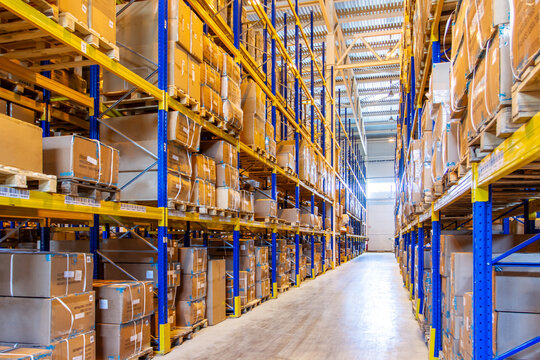
7 Best Tips for Inventory Management To Avoid Losses | Image source: AR Racking
Inventory management is likely the most crucial success component if you sell products through an online store. Actually, it’s extremely easy to do that. Imagine launching a successful marketing campaign and seeing sales orders pour in, only to discover that the product is actually out of stock. As a result of only investing in an expensive marketing strategy, you immediately miss the point. The fact that customers have to wait longer than expected for a product that is not in stock will also make them dissatisfied.
In a nutshell, a situation to avoid. Your stock flows must be managed as effectively as possible. After that, you confirm that there is enough stock on hand. However, stock management offers much more than just the quantity of a certain commodity in stock. We’ll offer you some pointers for managing your stock in this article.
Read also: How to Manage a Warehouse: The 10-Step Guide to Logistics Management
What is Inventory Management?
Before we offer you any advice, let’s define stock management for ourselves. Controlling the movement of items within your business is inventory management. As a result, you maintain accurate records of the products that enter and exit your warehouse or storage facility. You should make every effort to keep storage expenses as low as possible because it costs money to store goods. How? For instance, by keeping the goods on hand for a brief length of time. Long-standing inventory in your warehouse does not make money!
However, you must keep adequate inventory on hand to meet demand. Finding a healthy balance is an art. Thankfully, it’s not a wet finger job, but with efficient inventory management, you can optimize the product flows coming in and going out. In the end, this will result in increased sales, happier consumers, and profit maximization. You also develop committed and repeat consumers in addition to satisfied ones! Seven suggestions that can improve your inventory management are provided below.
1. Track stock
Of course, the first thing to consider is whether or not the stock is being monitored. It is crucial that you map your stock and gather enough information. You may use the variety of valuable information in this data as a business owner. So, using this information as a basis, you can come to wise and informed conclusions. There are various methods for tracking inventory. We briefly mention them here.
- Using a manual pen and paper
- Using Excel or a similar software on a PC
- With a WMS system that continuously monitors the stock
Your needs will determine which method you prefer. We generally recommend using a WMS system because it is precise and may generate numerous intriguing statistics on its own. A WMS system costs little money, but it can save a lot of time and cut down on errors to an absolute minimum.
2. Use one stock management system or WMS system
The first tip actually brings us seamlessly to the second tip. We absolutely recommend that you use a stock management system. Such a system will help you with stock management. You can control the flow of goods perfectly and have them move through the warehouse in a certain flow. Thanks to a WMS system, you can process orders more efficiently. For example, you can process orders in bulk while the system indicates the most logical picking route through the warehouse based on the created warehouse locations.
Yet too often we see entrepreneurs using multiple ways to manage stock. Collecting data from different sources is very time-consuming and increases the risk of errors. So you have to opt for one centralized system.
3. Create insight into the stock data
When an online store first opens, it frequently has a small selection of items, but that number quickly grows. It’s critical to properly organize data so that you can maintain an overview of the whole spectrum. If you don’t do this, there’s a good possibility that you’ll gradually lose the overview and end up choosing the wrong course of action.
You need to use items like Stock Keeping Units (SKU), stock costs, lot numbers, expiration dates, warehouse locations, supplier information, and courier information to acquire insight into the stock data.
We also remark that using a WMS system and maintaining a well-organized stock go hand in hand. You can process all of the stock information in a WMS system if you use one.

7 Best Tips for Inventory Management To Avoid Losses | Image source: Adobe Stock
4. Avoid stock loss
Many companies begin with the notion that a product they buy will actually be sold. You may frequently turn around from a long journey if you start with this idea. Inventory loss is inevitable. The trick is to keep stock losses to a minimum because they can drastically lower profitability.
Damage, theft, lost storage, expiration dates, and administrative mistakes are just a few of the many factors that can lead to inventory loss. Administrative mistakes account for 15% of stock losses, according to research. Some issues, like theft, are out of your hands entirely, but you do have complete control over management. A stock management system can help here as well! But another choice is to outsource the logistics. A fulfillment partner is highly skilled at controlling a huge inventory. A fulfillment partner can reduce inventory loss from damage, improper storage, theft (better security), and administrative mistakes to a level that you will never be able to reach.
Feel free to contact us to take care of your logistics!
5. The turnover rate
Selling items that are not in stock makes no sense logically. However, a lot of online retailers are able to run out of their best-selling items. This not only results in lost sales opportunities but may also discourage customers from visiting the store again. A situation ought to be avoided at all costs! How do you stay out of this dilemma? by figuring out your products’ turnover rate. These calculations allow you to more accurately predict when you should place your order and how long it will be until the stock runs out. Always consider the supplier’s delivery schedule.
6. Get started with obsolete inventory
Of course, some things sell more slowly than others. These goods frequently find themselves in a neglected spot. Also avoid doing this, because it keeps you from buying new inventory and drives up warehouse costs, obsolete inventory can lower earnings. You may avoid these mistakes and eventually enhance profitability by effectively managing inventories. Additionally, as the market gets overrun with innovations, the value of outmoded inventories is falling.
The turnover rate is not the appropriate measure in this situation. Although sales are high, you can still have a poor turnover rate. Because, for instance, there is a lot of stock. We need to identify the inactive supply in this instance. A report with the idle stock is promptly displayed by an inventory management system. Once the inactive supply has been identified, it must be cut off. Conducting focused marketing initiatives will help you achieve this.
7. Map out all costs
Managing your inventory involves more than just keeping track of the goods you sell. You must budget all costs if you want to have a profitable internet store. So factor in expenses for things like storage (warehouse), shipment boxes, packing supplies, and mailing labels.
The profit margin can be calculated using these expenses. A crucial task that every entrepreneur should do!



